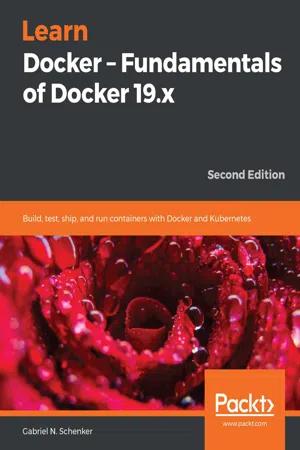
Learn Docker – Fundamentals of Docker 19.x
Build, test, ship, and run containers with Docker and Kubernetes, 2nd Edition
- 592 pages
- English
- ePUB (mobile friendly)
- Available on iOS & Android
Learn Docker – Fundamentals of Docker 19.x
Build, test, ship, and run containers with Docker and Kubernetes, 2nd Edition
About this book
Explore the core functionality of containerizing your applications and making them production-ready
Key Features
- Grasp basic to advanced Docker concepts with this comprehensive guide
- Get acquainted with Docker containers, Docker images, orchestrators, cloud integration, and networking
- Learn to simplify dependencies and deploy and test containers in production
Book Description
Containers enable you to package an application with all the components it needs, such as libraries and other dependencies, and ship it as one package. Docker containers have revolutionized the software supply chain in both small and large enterprises.
Starting with an introduction to Docker fundamentals and setting up an environment to work with it, you'll delve into concepts such as Docker containers, Docker images, and Docker Compose. As you progress, the book will help you explore deployment, orchestration, networking, and security. Finally, you'll get to grips with Docker functionalities on public clouds such as Amazon Web Services (AWS), Azure, and Google Cloud Platform (GCP), and learn about Docker Enterprise Edition features. Additionally, you'll also discover the benefits of increased security with the use of containers.
By the end of this Docker book, you'll be able to build, ship, and run a containerized, highly distributed application on Docker Swarm or Kubernetes, running on-premises or in the cloud.
What you will learn
- Containerize your traditional or microservice-based applications
- Develop, modify, debug, and test an application running inside a container
- Share or ship your application as an immutable container image
- Build a Docker Swarm and a Kubernetes cluster in the cloud
- Run a highly distributed application using Docker Swarm or Kubernetes
- Update or rollback a distributed application with zero downtime
- Secure your applications with encapsulation, networks, and secrets
- Troubleshoot a containerized, highly distributed application in the cloud
Who this book is for
This book is for Linux professionals, system administrators, operations engineers, DevOps engineers, and developers or stakeholders who are interested in getting started with Docker from scratch. No prior experience with Docker containers is required. Users with a Linux system would be able to take full advantage of this book.
Frequently asked questions
- Essential is ideal for learners and professionals who enjoy exploring a wide range of subjects. Access the Essential Library with 800,000+ trusted titles and best-sellers across business, personal growth, and the humanities. Includes unlimited reading time and Standard Read Aloud voice.
- Complete: Perfect for advanced learners and researchers needing full, unrestricted access. Unlock 1.4M+ books across hundreds of subjects, including academic and specialized titles. The Complete Plan also includes advanced features like Premium Read Aloud and Research Assistant.
Please note we cannot support devices running on iOS 13 and Android 7 or earlier. Learn more about using the app.
Information
Section 1: Motivation and Getting Started
- Chapter 1, What Are Containers and Why Should I Use Them?
- Chapter 2, Setting Up a Working Environment
What Are Containers and Why Should I Use Them?
- What are containers?
- Why are containers important?
- What's the benefit for me or for my company?
- The Moby project
- Docker products
- Container architecture
- Explain what containers are, using an analogy such as physical containers, in a few simple sentences to an interested layman
- Justify why containers are so important using an analogy such as physical containers versus traditional shipping or apartment homes versus single-family homes, and so on, to an interested lay person
- Name at least four upstream open source components that are used by Docker products, such as Docker for Desktop
- Identify at least three Docker products
What are containers?
Why are containers important?
Table of contents
- Title Page
- Copyright and Credits
- About Packt
- Contributors
- Preface
- Section 1: Motivation and Getting Started
- What Are Containers and Why Should I Use Them?
- Setting Up a Working Environment
- Section 2: Containerization, from Beginner to Black Belt
- Mastering Containers
- Creating and Managing Container Images
- Data Volumes and Configuration
- Debugging Code Running in Containers
- Using Docker to Supercharge Automation
- Advanced Docker Usage Scenarios
- Section 3: Orchestration Fundamentals and Docker Swarm
- Distributed Application Architecture
- Single-Host Networking
- Docker Compose
- Orchestrators
- Introduction to Docker Swarm
- Zero-Downtime Deployments and Secrets
- Section 4: Docker, Kubernetes, and the Cloud
- Introduction to Kubernetes
- Deploying, Updating, and Securing an Application with Kubernetes
- Monitoring and Troubleshooting an App Running in Production
- Running a Containerized App in the Cloud
- Assessments
- Other Books You May Enjoy